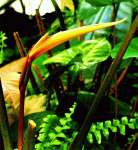From: Steve at ExoticRainforest.com (ExoticRainforest) on 2008.03.09 at 21:51:44(17146)

Thanks Harry, Brian and Windy. This is the problem I'm seeing.
Up here my guess has been a Xanthosoma due to the huge corm. But the lobes of the leaves are rounded as would be normal for a Colocasia. They also come back year after year which would be more indicative of a Colocasia, but the corm appears different. I've photographed the spathe and spadix of Colocasia esculenta Black Magic several times and the spathe is a beautiful yellow with red. My photo is attached. But a friend sent me photos of an "Elephant Ear" that looked more like a Xanthosoma with squared off lobes. His produced a white spathe. That is where I'm confused.
I've received a couple of private emails on this subject that explain it is simply Colocasia esculenta. I can certainly accept that with no problem since I know that species produces a wide variety of leaf forms and is commonly used as a food crop. But within some species are the inflorescneces variable as well?
As Windy described, Xanthosoma sagittifolium can produce a slightly pinkish spathe. But I've seen the same species (supposedly) in South Florida with a pure white spathe. There are huge fields of them grown out near the Everglades not far from Denis' operation as a food crop and sold in South Florida grocery stores. I had a Florida botanist tell me those were all Xanthosoma sagittifolium. But I know those stores also sell the corms of Colocasia esculenta. Are all these species so variable they can not only produce a variety of leaf forms, but also a variety of inflorescences as well? That would seem to violate the generally accepted tennant that the shape and color of the spathe indicates the species.
I understand, I think. But I'm still confused! And so are a bunch of people who are posting on some of the garden sites and calling Philodendron, Anthurium, Xanthosoma, Caladium, Colocasia and others "Elephant Ears"! Basically, anything with a large leaf is now being called using the same term!
Steve Lucas
| 


